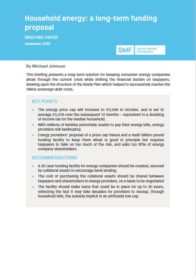This briefing presents a long-term solution for keeping consumer energy companies afloat through the current crisis while limiting the financial burden on taxpayers, drawing upon the structure of the Brady Plan which helped to successfully resolve the 1980s sovereign debt crisis.
KEY POINTS
- The energy price cap will increase to £3,549 in October, and is set to average £5,519 over the subsequent 12 months – equivalent to a doubling of income tax for the median household.
- With millions of families potentially unable to pay their energy bills, energy providers risk bankruptcy.
- Energy providers’ proposal of a price cap freeze and a multi-billion-pound funding facility to keep them afloat is good in principle but requires taxpayers to take on too much of the risk, and asks too little of energy company shareholders.
RECOMMENDATIONS
- A 30-year funding facility for energy companies should be created, secured by collateral assets to encourage bank lending.
- The cost of purchasing the collateral assets should be shared between taxpayers and shareholders in energy providers, on a basis to be negotiated.
- The facility should make loans that could be in place for up to 30 years, reflecting the fact it may take decades for providers to recoup (through household bills) the subsidy implicit in an artificially low cap.

